A review of 6 known medicinal mushrooms focusing on their practical uses to improve our health.
Medicinal mushrooms exhibit significant potential in treating and preventing a variety of diseases and health conditions. These include improving blood sugar balance, enhancing immune system activity, protecting the heart and liver, offering antioxidant benefits, reducing cholesterol, and providing anti-cancer, anti-inflammatory, and anti-viral properties.
Many essential medicines are derived from medicinal mushrooms, such as antibiotics like penicillin, discovered in 1928 by Alexander Fleming and secreted by Penicillium fungus strains. Statins, initially derived from mushrooms and now chemically synthesized, and antifungal drugs like griseofulvin, as well as immunosuppressive drugs such as cyclosporine, also have their origins in these fungi.
This article will delve into the medical applications of several notable medicinal mushrooms.
Cordyceps (Chinese Caterpillar Fungus)
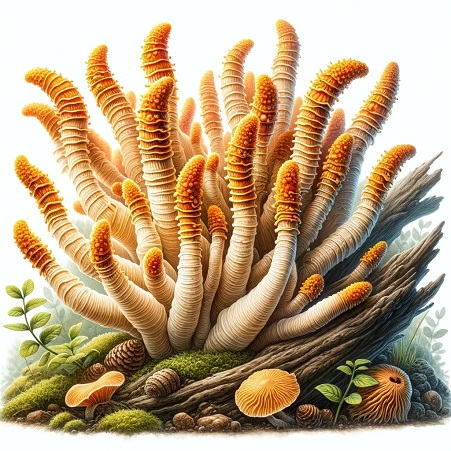
The Cordyceps mushroom, scientifically known as Cordyceps (Ophiocordyceps) Sinensis, also referred to as the Chinese caterpillar mushroom or the “Emperor Mushroom,” is a rare and highly prized mushroom.
Genetically, fungi are more closely related to humans than to plants.
Fact 1 of 4
Its rarity and difficulty in natural harvest make it one of the most expensive mushrooms globally.
Chinese and Tibetan medicinal texts list hundreds of Cordyceps species, known for their use in alleviating exhaustion, mental stress, and enhancing energy and endurance.
Improving Athletic Performance
Studies show that Cordyceps can boost cellular ATP production (a source of energy) in animals. A 2004 study[1] found that both wild and cultured Cordyceps positively impacted rodents’ heart muscle ATP generation.
A 2010 double-blind, placebo-controlled trial revealed[2] that Cordyceps supplements enhanced athletic performance in healthy adults, suggesting their potential use for athletic enhancement.
Treatment of Immunological Diseases
A 2010 study[3] examining the immunostimulatory effects of Cordyceps extract on macrophages indicated an increase in pro-inflammatory cytokines. This suggests its potential in bolstering the immune system for treating immunological diseases.
Improving Sexual Function
Various Cordyceps types may influence hormone levels, potentially increasing libido in women and enhancing sperm health in men.
Fungi rank as the Earth’s largest organisms.
Fact 2 of 4
A 2020 study[4] tested the effects of cultivated Cordyceps militaris on sexual performance in diabetic male rats. The mushroom showed significant improvements in mating desire, erection, testicular function, and testosterone levels in diabetic rats.
A 1988 article[5] reported that a Cordyceps militaris supplement given to 189 men and women with low libido resulted in 66% experiencing increased desire. A 2008 article found [6]that the supplement improved libido in 86% of women.
Lion’s Mane
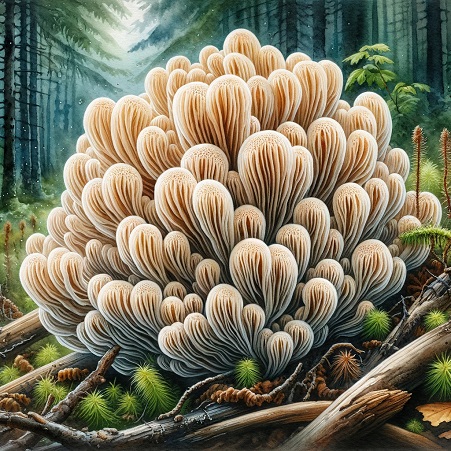
The Hericium mushroom, commonly known as Lion’s Mane (Hericium erinaceus), contains valuable compounds like beta-glucans, antioxidant-rich fibrous polysaccharides, immunomodulating agents, and neuroprotective phytonutrients.
Uses in Folk Medicine
Resembling a lion’s mane with its long, shaggy spikes, this mushroom grows on tree trunks and has been used in Chinese medicine to treat spleen issues, mental stress, energy deficits, and digestive problems. Buddhist monks have historically used Hericium tea to enhance concentration during meditation.
Neuroactive and Cognitive Activities
A 2013 in vitro study[7] showed that neuroactive compounds in Hericium induced nerve growth factor secretion in nerve cells, promoting growth in NG108-15 cells.
This aligns with other studies demonstrating nerve tissue growth supporting motor functions.
A 2018 study[8] indicated that Lion’s Mane compounds could inhibit nerve cell death in rats with neurodegenerative diseases and promote recovery and nerve regeneration in neuropathic pain and presbycusis (age-related hearing loss).
Reishi
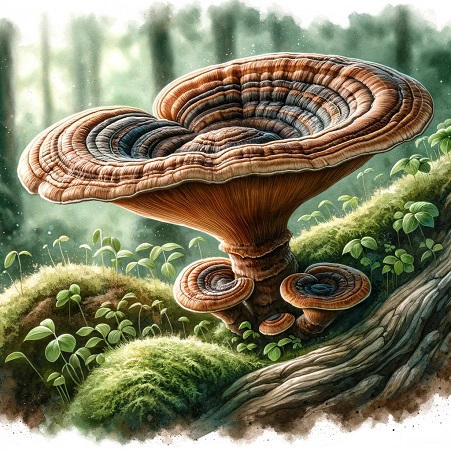
The Reishi mushroom, or Ganoderma Lucidum, also known as the “Mushroom of Immortality,” is prevalent across Asia and holds a revered place in traditional Chinese medicine.
Fungi facilitate communication between trees by connecting their root systems.
Fact 3 of 4
This mushroom, existing in various colors, is historically described as life-extending and even offering eternal life. It’s considered a life-span extending food and classified as an anti-aging agent. Its components include triterpenes, polysaccharides, proteoglycans, and amino acids.
The polysaccharides in Reishi support[9] immune function[10] and, when taken long-term, can improve sleep quality, calmness, stress reduction, inflammation regulation, respiratory function, and blood sugar balance.
Two randomized controlled trials in 2003 using a patented Reishi product showed promising results.
The first[11], involving 134 advanced cancer patients, demonstrated a significant increase in cellular immunity with 1800 mg daily for 12 weeks. The second study[12] with 68 lung cancer patients showed improved immune parameters and enhanced quality of life in about 65% of participants.
Chaga
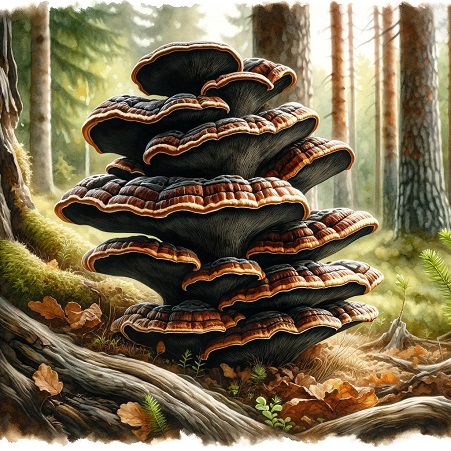
Chaga (Inonotus obliquus) is a parasitic fungus found on trees, especially firs, and is consumed as food. It thrives in cold Northern Hemisphere regions like Siberia, Alaska, Northern Canada, and North America, earning the nickname “Black Gold.”
Rich in antioxidants, Chaga contains various vitamins and minerals, including manganese, calcium, iron, selenium, and zinc. It also possesses antibacterial, antimicrobial, and anti-inflammatory properties[13].
Numerous preclinical studies[14] suggest Chaga’s health benefits. It supports digestive and immune system functioning, regulates inflammation, lowers LDL cholesterol, and contains adaptogenic and significant antimicrobial substances.
Coriolus (Turkey Tail)
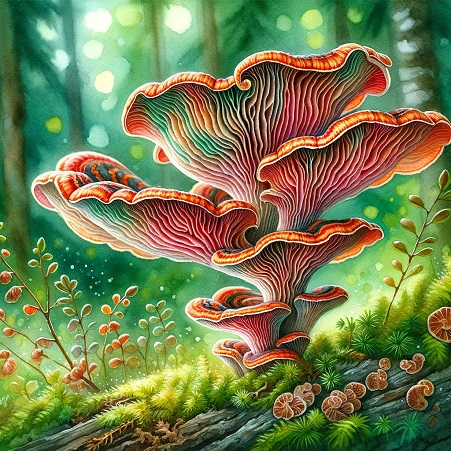
The Coriolus mushroom, also known as Trametes versicolor or “Turkey Tail,” is a uniquely colored and patterned mushroom found worldwide on dead trees.
Used in Chinese medicine to enhance digestive and lung health and overall vitality, its active components include polysaccharides, peptides, terpenes, phenolic compounds, sterols, amino acids, fatty acids, vitamins, and minerals.
Strong polysaccharides in Coriolus, particularly beta-glucans, bolster immune system activity by stimulating cytokine production and enhancing key immune cells like T cells, as supported by scientific studies[15].
Maitake
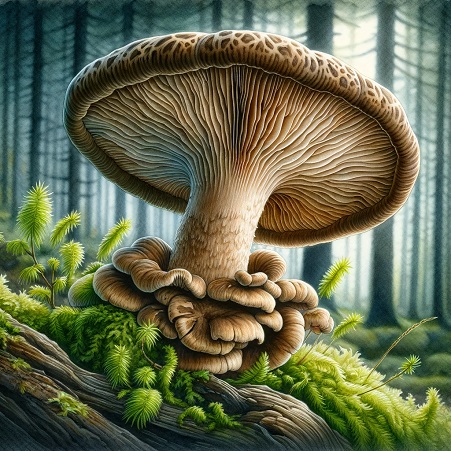
Among fresh produce, mushrooms are unique in their ability to produce vitamin D.
Fact 4 of 4
The Maitake mushroom, Grifola frondosa, also known as the “Dancing Mushroom,” is an edible fungus commonly found in cool forest conditions.
It grows on both living and dead tree trunks across Asia, China, Japan, and North America, and can reach weights up to 50 kg.
Maitake supports[16] the immune system, maintains normal blood pressure, and activates lymphocytes, monocytes, and helper T cells.
Traditional Chinese medicine utilized it for spleen support, blood and heart strengthening, and anemia treatment. Similar to Coriolus,
Maitake also contains polysaccharides linked to normal cellular growth and turnover.
Bibliography
- [1] Siu KM, Mak DH, Chiu PY, Poon MK, Du Y, Ko KM. Pharmacological basis of ‘Yin-nourishing’ and ‘Yang-invigorating’ actions of Cordyceps, a Chinese tonifying herb. Life Sci. 2004 Dec 10;76(4):385-95. doi: 10.1016/j.lfs.2004.07.014. PMID: 15530501. https://pubmed.ncbi.nlm.nih.gov/15530501/
- [2] Chen S, Li Z, Krochmal R, Abrazado M, Kim W, Cooper CB. Effect of Cs-4 (Cordyceps sinensis) on exercise performance in healthy older subjects: a double-blind, placebo-controlled trial. J Altern Complement Med. 2010 May;16(5):585-90. doi: 10.1089/acm.2009.0226. PMID: 20804368; PMCID: PMC3110835. https://www.ncbi.nlm.nih.gov/pmc/articles/PMC3110835/
- [3] Shin S, Kwon J, Lee S, Kong H, Lee S, Lee CK, Cho K, Ha NJ, Kim K. Immunostimulatory Effects of Cordyceps militaris on Macrophages through the Enhanced Production of Cytokines via the Activation of NF-kappaB. Immune Netw. 2010 Apr;10(2):55-63. doi: 10.4110/in.2010.10.2.55. Epub 2010 Apr 30. PMID: 20532125; PMCID: PMC2881426. https://www.ncbi.nlm.nih.gov/pmc/articles/PMC2881426/
- [4] Pohsa S, Hanchang W, Singpoonga N, Chaiprasart P, Taepavarapruk P. Effects of Cultured Cordycep militaris on Sexual Performance and Erectile Function in Streptozotocin-Induced Diabetic Male Rats. Biomed Res Int. 2020 Nov 13;2020:4198397. doi: 10.1155/2020/4198397. PMID: 33274209; PMCID: PMC7683110. https://www.ncbi.nlm.nih.gov/pmc/articles/PMC7683110/
- [5] Wan, F., Y. Guo, and X. Deng. "Sex hormone-like effects of JinShuiBao [Cs-4] capsule: pharmacological and clinical studies." Chinese Trad Patent Med 9 (1988): 29-31.
- [6] 6. Dong CH, Yao YJ. In vitro evaluation of antioxidant activities of aqueous extracts from natural and cultured mycelia of Cordyceps sinensis. LWT-Food Sci Technol. 2008;41:669–77. https://www.sciencedirect.com/science/article/pii/S002364380700182X
- [7] Lai PL, Naidu M, Sabaratnam V, Wong KH, David RP, Kuppusamy UR, Abdullah N, Malek SN. Neurotrophic properties of the Lion’s mane medicinal mushroom, Hericium erinaceus (Higher Basidiomycetes) from Malaysia. Int J Med Mushrooms. 2013;15(6):539-54. doi: 10.1615/intjmedmushr.v15.i6.30. PMID: 24266378. https://pubmed.ncbi.nlm.nih.gov/24266378/
- [8] Li IC, Lee LY, Tzeng TT, Chen WP, Chen YP, Shiao YJ, Chen CC. Neurohealth Properties of Hericium erinaceus Mycelia Enriched with Erinacines. Behav Neurol. 2018 May 21;2018:5802634. doi: 10.1155/2018/5802634. PMID: 29951133; PMCID: PMC5987239. https://www.ncbi.nlm.nih.gov/pmc/articles/PMC5987239/
- [9] Bao X, Liu C, Fang J, Li X. Structural and immunological studies of a major polysaccharide from spores of Ganoderma lucidum (Fr.) Karst. Carbohydr Res. 2001;332:67–74. https://pubmed.ncbi.nlm.nih.gov/11403089/
- [10] Wachtel-Galor S, Buswell J. A, Tomlinson B, Benzie I. F. F. Lingzhi polyphorous fungus. In: Herbal and Traditional Medicine: Molecular Aspects of Health. New York: Marcel Dekker Inc; 2004. pp. 179–228.
- [11] Gao Y. H, Sai X. H, Chen G. L, Ye J. X, Zhou S. F. A randomized, placebo-controlled, multi-center study of Ganoderma lucidum (W. Curt.: Fr.) Lloyd (Aphyllophoromycetideae) polysaccharides (Ganopoly) in patients with advanced lung cancer. Int J Med Mushrooms. 2003;5:368–81.
- [12] Gao Y. H, Zhou S. F, Jiang W. Q, Huang M, Sai X. H. Effects of Ganopoly (a Ganoderma lucidum polysaccharide extract) on immune functions in advanced-stage cancer patients. Immunol Invest. 2003;32:201–15. https://pubmed.ncbi.nlm.nih.gov/12916709/
- [13] Szychowski KA, Skóra B, Pomianek T, Gmiński J. Inonotus obliquus – from folk medicine to clinical use. J Tradit Complement Med. 2020 Aug 22;11(4):293-302. doi: 10.1016/j.jtcme.2020.08.003. PMID: 34195023; PMCID: PMC8240111. https://www.ncbi.nlm.nih.gov/pmc/articles/PMC8240111/
- [14] 14. https://www.ncbi.nlm.nih.gov/books/NBK493173/
- [15] 15. Wong CK, Tse PS, Wong EL, Leung PC, Fung KP, Lam CW. Immunomodulatory effects of yun zhi and danshen capsules in health subjects–a randomized, double-blind, placebo-controlled, crossover study. Int Immunopharmacol. 2004 Feb;4(2):201-11. doi: 10.1016/j.intimp.2003.12.003. PMID: 14996412. https://pubmed.ncbi.nlm.nih.gov/14996412/
- [16] Inoue A, Kodama N, Nanba H. Effect of maitake (Grifola frondosa) D-fraction on the control of the T lymph node Th-1/Th-2 proportion. Biol Pharm Bull. 2002 Apr;25(4):536-40. doi: 10.1248/bpb.25.536. PMID: 11995941. https://pubmed.ncbi.nlm.nih.gov/11995941/

